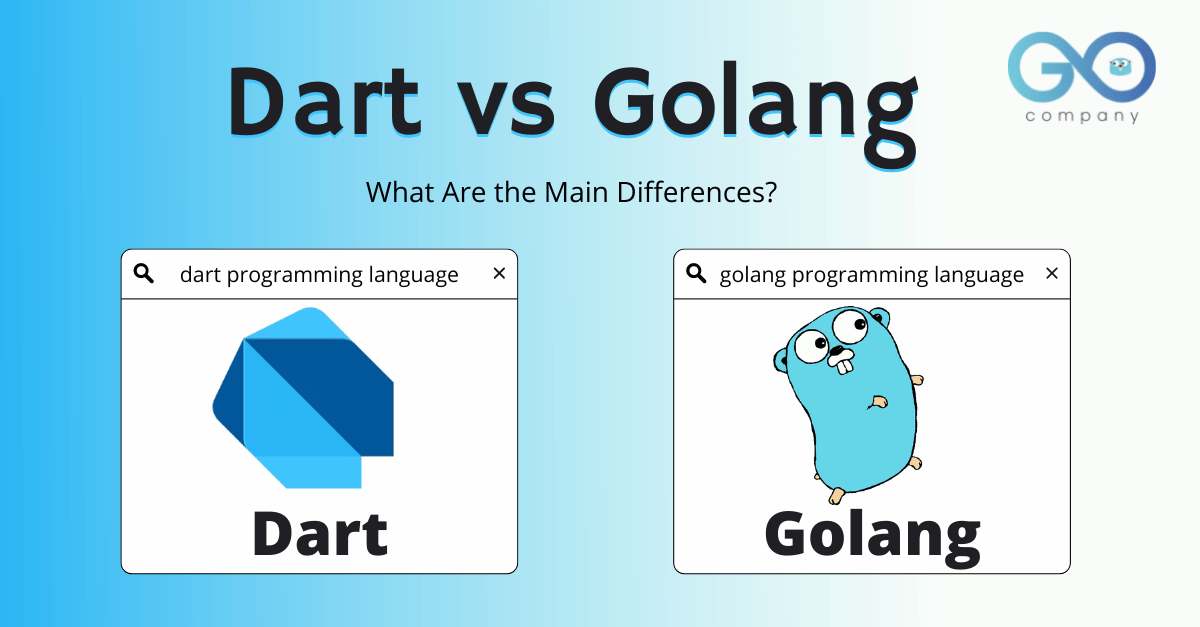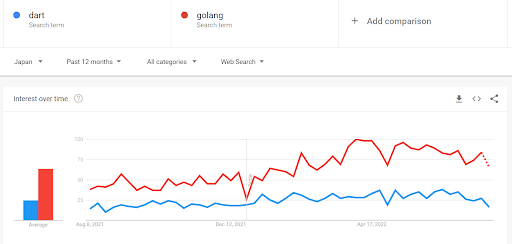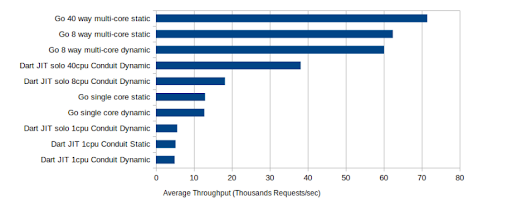Dart vs Golang: What Are the Main Differences?

There will always be a comparison between two different programming languages, especially when both the programming languages have been developed by Google. You might have guessed it by reading the title. In this blog, we will take a look at the differences between Dart and Golang.
Developers involved in Go lang development might be skeptical about pursuing another language like Dart. But, there is no harm in assessing the differences and checking out the features, right? So, let us have a look at the major differences between Golang and Dart.
Major differences between Golang and Dart
Paradigm
- Dart is a cohesive scalable programming language that is intended for user side and server side. It is an open-source programming language as well. You can use the language to create simple scripted apps. It is a statically typed language having certain attributes of dynamically typed languages.
- On the contrary, Golang is another open-source programming language that is especially used in the server side and back-end development. It is also used for web applications and cloud computing. It was designed to tackle scalability issues at Google and is a statically typed language.
Interpreter or Compiler
- Dart can be referred to as an interpreted compiler language. Why? This is because when it comes to an application in Node.js, it can be compiled into the native code. In addition to this, the Dart Virtual Machine behaves as an interpreter.
- On the other hand, Golang is a fast, compiled language. To run a program, we must run the source code files via a compiler, which goes through the source code and creates an executable, or binary file.
Speed
- When it comes to speed, Dart is fairly fast. However, it falls short when compared to Golang. For instance, if you were to execute a program, or resize an image, it would take Dart thrice the time taken by Golang to perform the tasks. Thus, it is used with Flutter to create mobile applications.
- Thanks to the CSP-style concurrency and parallelism, Golang is extremely fast. In fact, it is faster than Python, JavaScript, Dart, etc. Hence, it is widely used to develop huge distributed systems and network servers.
This is the main reason why developers opt for Golang instead of Dart. And this is evident from the graph below as well.

SDK (Software Development Kit)
- Dart has its individual SDK which consists of tools and libraries to develop the apps. It consists of lib, bin, and include directories. And it also comprises version, LICENSE, and README files. When it comes to tools, it has dartfmt, dartdevc, DartVM, dartanalyzer, etc.
- In Golang, package sdk denotes the official AWS SDK. This SDK offers utilities and APIs that developers can rely on to create Golang applications using AWS services. These include Amazon Simple Storage Service (Amazon S3) and Amazon Elastic Compute Cloud (Amazon EC2).
OOPs Features, and Constructors and Destructors
- Dart exhibits various object-oriented programming language features like classes, constructors and deconstructors.
- On the other hand, Golang does not have classes, and no scope for default constructors and destructors. The programming language is similar to C, in that, it has structural typing, garbage collection, memory safety, and heavy use of packages.
Passing of Map
- The reference (pointer) is passed by value if a map (or any other object) is passed as a parameter. The caller-passed-through value object is still referenced in the copy. This indicates that changing the object that toUpgrade references to does not alter the caller site's reference.
- In Golang, maps are passed by reference. Much like channels, maps are treated like pointers for runtime types. Maps consist of the same semantics like the pointer values in Go program.
Threading
- Dart is single threaded. This refers to the fact that all of the application codes run in the same thread. In Flutter, the Dart code usually runs on the User Interface thread. However, Flutter makes use of several threads like I/O thread, Platform thread to do its work.
- Golang development usually relies on goroutines and channels. A goroutine is a function that runs simultaneously with the rest of the program and is a lightweight execution thread. And a channel is a media which paves the way for various goroutines to communicate with each other. And the communication process takes place with the help of a timer.

The graph above shows how Go performs better than Dart when it is allowed to use all the 8 cores.
Iterations (Loop Options)
- Dart consists of while and do while iterative loops. Every time the stated condition evaluates to true, the while loop begins executing the instructions. In other words, before the code is executed, the loop assesses the condition. The do_while is almost similar to the while loop. However, the condition is not evaluated for the first time.
- Golang does not have provision for while and do while statements. However, you can modify the for loop as a while loop while coding.
Inheritance
- Dart has provision for inheritance. The phenomenon is quite interesting as one class (child class) is able to derive the characteristics and properties of another class (parent class). Thus, developers can create a new class from an already existing class.
- Developers cannot use inheritance in Golang. However, it can be compensated as you can use composition by embedding a struct type into another.
Support for Constants
- Dart supports constants. In fact, the concept of compile-time constants is prevalent in Dart. It is actually parsed and canonicalized, and created at compile time. However, the default values are excluded from the list as future Dart versions might reinforce non-constant default values.
- Golang does not support volatile qualifiers or constants. This is because Golang is a statically typed language (as mentioned before) and it does not allow operations that involve mixing of numeric types. For instance, you cannot add float64 to an int. The constants behave like regular numbers.
Asynchronous Operations
- Dart relies on Future objects to demonstrate asynchronous operations. Usually a program freezes if any code causes a disruption in the thread of execution, by blocking on I/O or waiting for a lengthy operation.
- As mentioned earlier, Golang makes use of channels to initiate communication between goroutines. Due to the presence of channels, there is proper synchronization. You can define the maximum number of goroutine threads during the compile time by using the GOMAXPROCS variable.
As you can see, no one programming language is clearly the dominating one. Both Golang and Dart have their unique purposes and features. While Dart may appeal to some developers, it may be resented by a few. The same scenario holds good for Golang.
So, it is you who have to decide whether you will opt for Dart or stick with Golang development depending on the task you are performing.